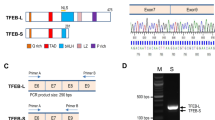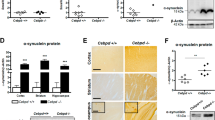Abstract
SET is elevated and mislocalized in the neuronal cytoplasm in brains of Alzheimer’s disease (AD) and Down syndrome (DS) patients. Cytoplasm SET leads to inhibition of protein phosphatase 2A and is involved in the tau pathology. However, the regulation of SET gene expression remains elusive. In the present study, we cloned a 1399-bp segment of the 5′ flanking region of the human SET gene and identified that the transcription start site (TSS) of SET transcript 1 is located at 123 bp upstream of the translation start site ATG in exon 1. Sequence analysis reveals several putative regulatory elements including NFkB, Sp1, and HSE. Luciferase assay and electrophoretic mobility shift assay (EMSA) identified a functional cis-acting NFkB-responsive element in the SET gene promoter. Overexpression and activation of NFkB upregulate transcription of SET isoform 1 but not isoform 2, indicating that the expression of these two isoforms is differentially regulated. The results demonstrate that NFkB plays an important role in regulation of the human SET gene expression. Our findings suggest that oxidative stress and inflammatory responses could result in abnormal SET gene expression, contributing to the tauopathy in AD pathogenesis.





Similar content being viewed by others
References
von Lindern M, van Baal S, Wiegant J, Raap A, Hagemeijer A, Grosveld G (1992) CAN, a putative oncogene associated with myeloid leukemogenesis, may be activated by fusion of its 3’ half to different genes: characterization of the set gene. Mol Cell Biol 12(8):3346–3355
Nagata K, Saito S, Okuwaki M, Kawase H, Furuya A, Kusano A, Hanai N, Okuda A, Kikuchi A (1998) Cellular localization and expression of template-activating factor I in different cell types. Exp Cell Res 240(2):274–281
Kim EG, Choi ME, Ballermann BJ (1994) Spatially restricted expression of set mRNA in developing rat kidney. Am J Physiol 266(1 Pt 2):F155–161
Fan Z, Beresford PJ, Zhang D, Xu Z, Novina CD, Yoshida A, Pommier Y, Lieberman J (2003) Cleaving the oxidative repair protein Ape1 enhances cell death mediated by granzyme A. Nat Immunol 4(2):145–153
Muto S, Senda M, Akai Y, Sato L, Suzuki T, Nagai R, Senda T, Horikoshi M (2007) Relationship between the structure of SET/TAF-Ibeta/INHAT and its histone chaperone activity. Proc Natl Acad Sci U S A 104(11):4285–4290
Nagata K, Kawase H, Handa H, Yano K, Yamasaki M, Ishimi Y, Okuda A, Kikuchi A, Matsumoto K (1995) Replication factor encoded by a putative oncogene, set, associated with myeloid leukemogenesis. Proc Natl Acad Sci U S A 92(10):4279–4283
Kato K, Miyaji-Yamaguchi M, Okuwaki M, Nagata K (2007) Histone acetylation-independent transcription stimulation by a histone chaperone. Nucleic Acids Res 35(3):705–715
Seo SB, McNamara P, Heo S, Turner A, Lane WS, Chakravarti D (2001) Regulation of histone acetylation and transcription by INHAT, a human cellular complex containing the set oncoprotein. Cell 104(1):119–130
Miyamoto S, Suzuki T, Muto S, Aizawa K, Kimura A, Mizuno Y, Nagino T, Imai Y, Adachi N, Horikoshi M, Nagai R (2003) Positive and negative regulation of the cardiovascular transcription factor KLF5 by p300 and the oncogenic regulator SET through interaction and acetylation on the DNA-binding domain. Mol Cell Biol 23(23):8528–8541
Li M, Makkinje A, Damuni Z (1996) The myeloid leukemia-associated protein SET is a potent inhibitor of protein phosphatase 2A. J Biol Chem 271(19):11059–11062
Carlson SG, Eng E, Kim EG, Perlman EJ, Copeland TD, Ballermann BJ (1998) Expression of SET, an inhibitor of protein phosphatase 2A, in renal development and Wilms’ tumor. JASN 9(10):1873–1880
Compagnone NA, Zhang P, Vigne JL, Mellon SH (2000) Novel role for the nuclear phosphoprotein SET in transcriptional activation of P450c17 and initiation of neurosteroidogenesis. Mol Endocrinol 14(6):875–888
Madeira A, Pommet JM, Prochiantz A, Allinquant B (2005) SET protein (TAF1beta, I2PP2A) is involved in neuronal apoptosis induced by an amyloid precursor protein cytoplasmic subdomain. FASEB J 19(13):1905–1907
Qu D, Zhang Y, Ma J, Guo K, Li R, Yin Y, Cao X, Park DS (2007) The nuclear localization of SET mediated by impalpha3/impbeta attenuates its cytosolic toxicity in neurons. J Neurochem 103(1):408–422
Wang X, Blanchard J, Kohlbrenner E, Clement N, Linden RM, Radu A, Grundke-Iqbal I, Iqbal K (2010) The carboxy-terminal fragment of inhibitor-2 of protein phosphatase-2A induces Alzheimer disease pathology and cognitive impairment. FASEB J 24(11):4420–4432
Arnaud L, Chen S, Liu F, Li B, Khatoon S, Grundke-Iqbal I, Iqbal K (2011) Mechanism of inhibition of PP2A activity and abnormal hyperphosphorylation of tau by I2(PP2A)/SET. FEBS Lett 585(17):2653–2659
Yu G, Yan T, Feng Y, Liu X, Xia Y, Luo H, Wang JZ, Wang X (2013) Ser9 phosphorylation causes cytoplasmic detention of I2PP2A/SET in Alzheimer disease. Neurobiol Aging 34(7):1748–1758
Arif M, Wei J, Zhang Q, Liu F, Basurto-Islas G, Grundke-Iqbal I, Iqbal K (2014) Cytoplasmic retention of protein phosphatase 2A inhibitor 2 (I2PP2A) induces Alzheimer-like abnormal hyperphosphorylation of tau. J Biol Chem 289(40):27677–27691
Zhang X, Wu Y, Duan X, Chen W, Zou H, Zhang M, Zhang S, Cai F, Song W (2015) Upregulation of SET expression by BACE1 and its implications in Down syndrome. Mol Neurobiol 51(2):781–790
Duan X, Tong J, Xu Q, Wu Y, Cai F, Li T, Song W (2014) Upregulation of human PINK1 gene expression by NFkappaB signalling. Mol Brain 7:57
Wang K, Liu S, Wang J, Wu Y, Cai F, Song W (2014) Transcriptional regulation of human USP24 gene expression by NF-kappa B. J Neurochem 128(6):818–828
Wang R, Zhang M, Zhou W, Ly PT, Cai F, Song W (2011) NF-kappaB signaling inhibits ubiquitin carboxyl-terminal hydrolase L1 gene expression. J Neurochem 116(6):1160–1170
Tanimukai H, Grundke-Iqbal I, Iqbal K (2005) Up-regulation of inhibitors of protein phosphatase-2A in Alzheimer’s disease. Am J Pathol 166(6):1761–1771
Facchinetti P, Dorard E, Contremoulins V, Gaillard MC, Deglon N, Sazdovitch V, Guihenneuc-Jouyaux C, Brouillet E, Duyckaerts C, Allinquant B (2014) SET translocation is associated with increase in caspase cleaved amyloid precursor protein in CA1 of Alzheimer and Down syndrome patients. Neurobiol Aging 35(5):958–968
Hanger DP, Betts JC, Loviny TL, Blackstock WP, Anderton BH (1998) New phosphorylation sites identified in hyperphosphorylated tau (paired helical filament-tau) from Alzheimer’s disease brain using nanoelectrospray mass spectrometry. J Neurochem 71(6):2465–2476
Liu F, Grundke-Iqbal I, Iqbal K, Gong CX (2005) Contributions of protein phosphatases PP1, PP2A, PP2B and PP5 to the regulation of tau phosphorylation. Eur J Neurosci 22(8):1942–1950
Trakhtenberg EF, Morkin MI, Patel KH, Fernandez SG, Sang A, Shaw P, Liu X, Wang Y, Mlacker GM, Gao H, Velmeshev D, Dombrowski SM, Vitek MP, Goldberg JL (2015) The N-terminal SET-beta protein isoform induces neuronal death. J Biol Chem 290(21):13417–13426
Asaka MN, Murano K, Nagata K (2008) Sp1-mediated transcription regulation of TAF-Ialpha gene encoding a histone chaperone. Biochem Biophys Res Commun 376(4):665–670
Baldwin AS Jr (1996) The NF-kappa B and I kappa B proteins: new discoveries and insights. Annu Rev Immunol 14:649–683
Gapuzan ME, Schmah O, Pollock AD, Hoffmann A, Gilmore TD (2005) Immortalized fibroblasts from NF-kappaB RelA knockout mice show phenotypic heterogeneity and maintain increased sensitivity to tumor necrosis factor alpha after transformation by v-Ras. Oncogene 24(43):6574–6583
Price JL, McKeel DW Jr, Buckles VD, Roe CM, Xiong C, Grundman M, Hansen LA, Petersen RC, Parisi JE, Dickson DW, Smith CD, Davis DG, Schmitt FA, Markesbery WR, Kaye J, Kurlan R, Hulette C, Kurland BF, Higdon R, Kukull W, Morris JC (2009) Neuropathology of nondemented aging: presumptive evidence for preclinical Alzheimer disease. Neurobiol Aging 30(7):1026–1036
Lovell MA, Ehmann WD, Butler SM, Markesbery WR (1995) Elevated thiobarbituric acid-reactive substances and antioxidant enzyme activity in the brain in Alzheimer’s disease. Neurology 45(8):1594–1601
Markesbery WR, Lovell MA (1998) Four-hydroxynonenal, a product of lipid peroxidation, is increased in the brain in Alzheimer’s disease. Neurobiol Aging 19(1):33–36
Aksenov MY, Aksenova MV, Butterfield DA, Geddes JW, Markesbery WR (2001) Protein oxidation in the brain in Alzheimer’s disease. Neuroscience 103(2):373–383
Shan X, Tashiro H, Lin CL (2003) The identification and characterization of oxidized RNAs in Alzheimer’s disease. J Neurosci 23(12):4913–4921
Anderson AJ, Su JH, Cotman CW (1996) DNA damage and apoptosis in Alzheimer’s disease: colocalization with c-Jun immunoreactivity, relationship to brain area, and effect of postmortem delay. J Neurosci 16(5):1710–1719
Venkateshappa C, Harish G, Mahadevan A, Srinivas Bharath MM, Shankar SK (2012) Elevated oxidative stress and decreased antioxidant function in the human hippocampus and frontal cortex with increasing age: implications for neurodegeneration in Alzheimer’s disease. Neurochem Res 37(8):1601–1614
Chen CH, Zhou W, Liu S, Deng Y, Cai F, Tone M, Tone Y, Tong Y, Song W (2012) Increased NF-kappaB signalling up-regulates BACE1 expression and its therapeutic potential in Alzheimer’s disease. Int J Neuropsychopharmacol 15(01):77–90
Ly PT, Wu Y, Zou H, Wang R, Zhou W, Kinoshita A, Zhang M, Yang Y, Cai F, Woodgett J, Song W (2013) Inhibition of GSK3beta-mediated BACE1 expression reduces Alzheimer-associated phenotypes. J Clin Invest 123(1):224–235
Acknowledgments
We thank Shasha Meng and Mingjing Liu for providing valuable comments and technique support. This work was supported by the Graduate Student Research Innovation Project of Chongqing, National Natural Science Foundation of China (NSFC) grant 81161120498 (T. L.), and Canadian Institutes of Health Research (CIHR) Grant TAD-117948 (W.S.). W.S. is the holder of the Tier 1 Canada Research Chair in Alzheimer’s disease.
Author information
Authors and Affiliations
Corresponding authors
Ethics declarations
Conflict of Interest
The authors declare that they have no competing financial interests.
Additional information
Yi Feng, Xiaoyong Li and Weitao Zhou contributed equally to this work.
Rights and permissions
About this article
Cite this article
Feng, Y., Li, X., Zhou, W. et al. Regulation of SET Gene Expression by NFkB. Mol Neurobiol 54, 4477–4485 (2017). https://doi.org/10.1007/s12035-016-9967-2
Received:
Accepted:
Published:
Issue Date:
DOI: https://doi.org/10.1007/s12035-016-9967-2




